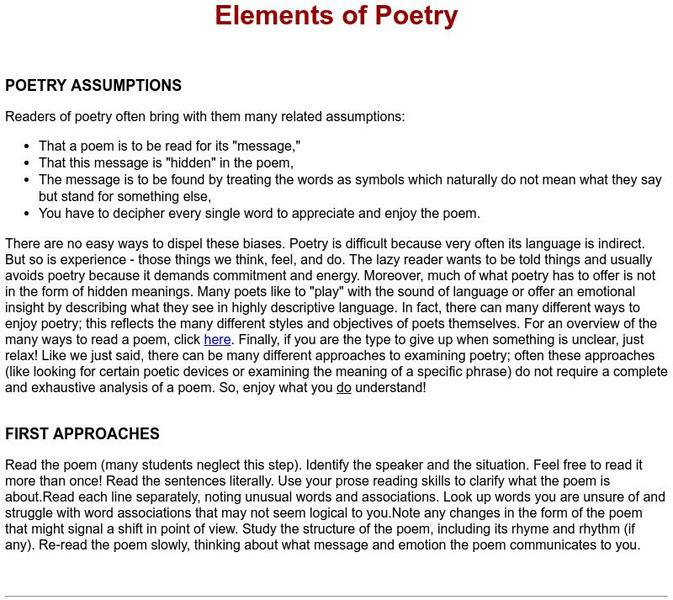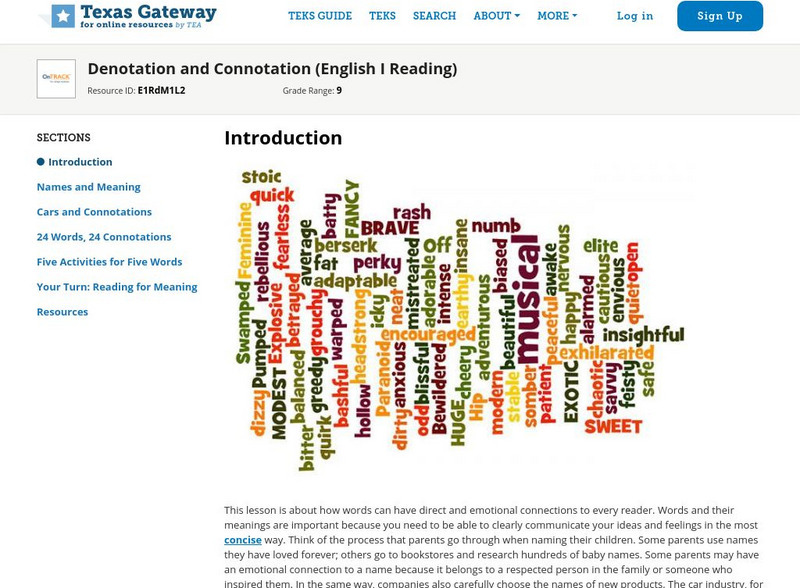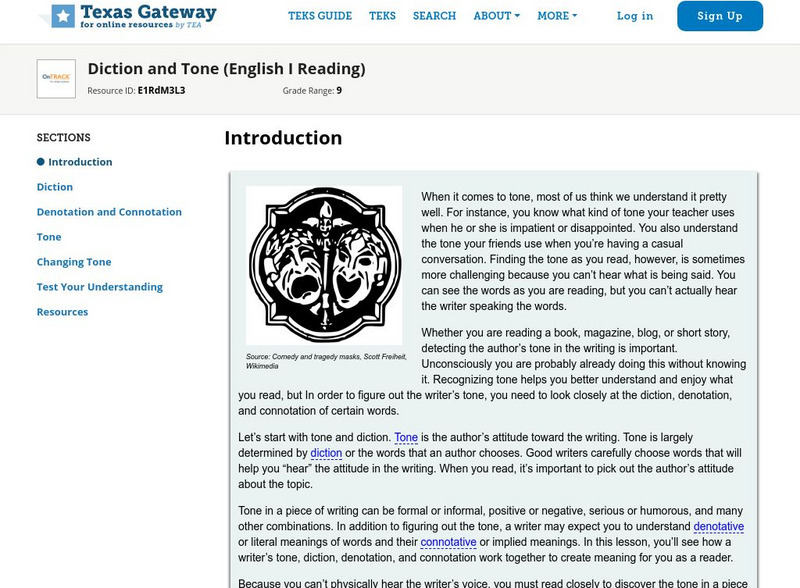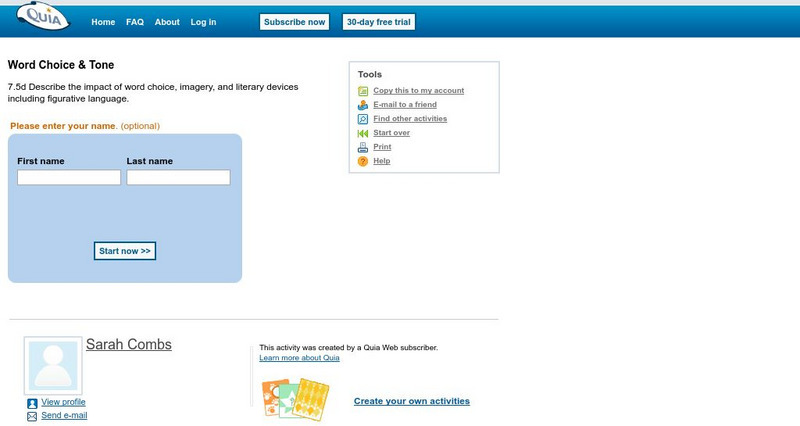Hi, what do you want to do?
Prestwick House
"Because I could not stop for Death" -- Visualizing Meaning and Tone
Emily Dickinson's "Because I could not stop for Death" provides high schoolers with an opportunity to practice their critical thinking skills. They examine the images, diction, rhythm, and rhyme scheme the poet uses and consider how...
Curated OER
Practice Book O
Whether you need resources for reading comprehension, literary analysis, phonics, vocabulary, or text features, an extensive packet of worksheets is sure to fit your needs. Based on a fifth-grade curriculum but applicable to any level of...
Curated OER
What's In a Name?
Introduce your language arts class to connotation, denotation, and diction. Middle schoolers identify and differentiate between the connotative and denotative meanings of words by analyzing the fictitious sports team names....
Scholastic
Lions, Tigers, and Slugs? Oh, My!
Explore the power of words with your class by analyzing the connotations of fictitious sports team names. Learners discuss team names and the mental images they convey. They create logos to illustrate the meanings and...
Other
The University of Wales: Semiotics for Beginners
Click on Denotation, Connotation, and Myth. A discourse in the use of "denotation" and "connotation" as they refer to semiotics and cultural myths.
ReadWriteThink
Read Write Think: Avalanche, Aztek, or Bravada? A Connotation Minilesson
Interesting instructional activity which stresses the importance of connotation in writing by examining car names. Middle schoolers participate in an interactive instructional activity in which they learn the value of connotation and...
Other
Lexiconic.net: Elements of Poetry
This resource explains how to approach an analysis of a poem. It discusses assumptions people may have, the importance of reading it closely before analyzing it, looking at the stanza structure, the type of poem, the sound patterns,...
Curated OER
Mc Graw Hill: Analyze Language Choices
Learn about figurative language and how to determine the figurative, denotative, and connotative meanings of words.
Polk Brothers Foundation Center for Urban Education at DePaul University
De Paul University: Center for Urban Education: Context to Determine Meaning of a Word [Pdf]
This learning module contains three nonfiction reading lessons that will assist student understand how to apply context clues when they encounter new vocabulary words.
Other
Ed Sitement! "Shooting an Elephant": George Orwell's Essay on His Life in Burma
This site shares a PDF worksheet for students to organize connotative and denotative meanings. Students will read "Shooting an Elephant" and then complete the chart with explanations of the denotative and connotative meanings. L.11-12.5b...
Other
Visual Thesaurus: Shades of Meaning
In this lesson, small groups of students will compete in a "shades of meaning" contest to see which group can use the Visual Thesaurus to help them match words with similar definitions but different connotations in the shortest amount of...
Sophia Learning
Sophia: Connotation: Lesson 2
This lesson introduces connotation and provides examples. It is 2 of 3 in the series titled "Connotation."
TES Global
Blendspace: Connotation/denotation
Work through links to activities, assessments, websites, and videos to learn about connotation and denotation.
Texas Education Agency
Texas Gateway: Reference Materials Printed and Electronic
Learn how to use dictionaries, glossaries, and thesauri in order to determine meanings of words and phrases, including their denotations, connotations, and etymologies.
Texas Education Agency
Texas Gateway: Denotation and Connotation (English I Reading)
Distinguish between the denotative (dictionary) meaning of a word and its connotative (emotions or associations that are implied rather than literal) meaning. L.9-10.5b nuances
Texas Education Agency
Texas Gateway: Reference Materials: Printed and Electronic
You will learn how to use dictionaries, glossaries, and thesauri in order to determine meanings of words and phrases, including their denotations, connotations, and etymologies.
Texas Education Agency
Texas Gateway: Denotation and Connotation (English Ii Reading)
You will be able to distinguish between the denotative (dictionary) meaning of a word and its connotative (emotions or associations that are implied rather than literal) meaning. L.9-10.5b nuances
Polk Brothers Foundation Center for Urban Education at DePaul University
De Paul University: Center for Urban Education: Can Infer Meaning of a Word in Context [Pdf]
This activity contains two graphic organizers that will help students infer the meaning of words in context. Students can use these graphic organizers as they read nonfiction texts, particularly while reading in the content area.
Texas Education Agency
Texas Gateway: Denotation and Connotation (English I Reading)
This lesson focuses on denotation and connotation including the abilty to distinguish words according to their emotional or cultural meaning. Your ability to do so can help you understand the author's purpose or more about a character in...
Texas Education Agency
Texas Gateway: Diction and Tone (English I Reading)
In this lesson, you'll see how a writer's tone, diction, denotation, and connotation work together to create meaning for you as a reader.
Texas Education Agency
Texas Gateway: Denotation and Connotation (English Ii Reading)
This lesson is about how words can have emotional connections for readers. Connotation and denotation are a part of language, and knowing about them can help you understand not only the author's purpose, but also the author's attitude...
Ted Nellen
Cyber English (By Ted Nellen): Literary Terms a E
The first of three pages of simple definitions for literary terms. This page, A - E, covers forty-four terms from "Allegory" to "Exposition."
Quia
Quia: Connotation and Denotation
Read a sentence and determine which word carries the most positive or negative connotation to fill in the blanks in this 18-question quiz.
Quia
Quia: Word Choice and Tone Quiz
This interactive series of questions assesses students' understanding of the impact of word choice on the tone of a passage. Students will identify the correct tone used in sentences, paragraphs, and poems.













![De Paul University: Center for Urban Education: Context to Determine Meaning of a Word [Pdf] Unit Plan De Paul University: Center for Urban Education: Context to Determine Meaning of a Word [Pdf] Unit Plan](https://content.lessonplanet.com/knovation/original/78066-aa29ca332d7e865b1a287e97a791cdc5.jpg?1661787064)












